Fall color, Cedar Waxwings, Wild Turkeys and a Cooper’s Hawk.
Yesterday was a fine morning to escape into the mountains. Skies were clear and very blue, I experienced my first freezing temperature of the season, a few birds were out and about and the company was good. Today’s post is more about the experience than about great bird photos.
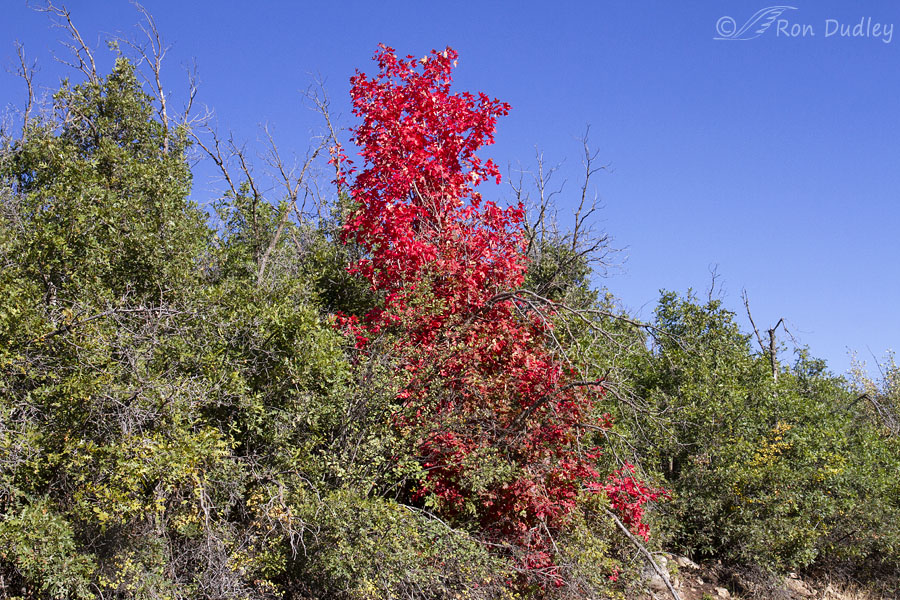
Colors at midlevel elevations are beginning to change, some of them to vivid colors.
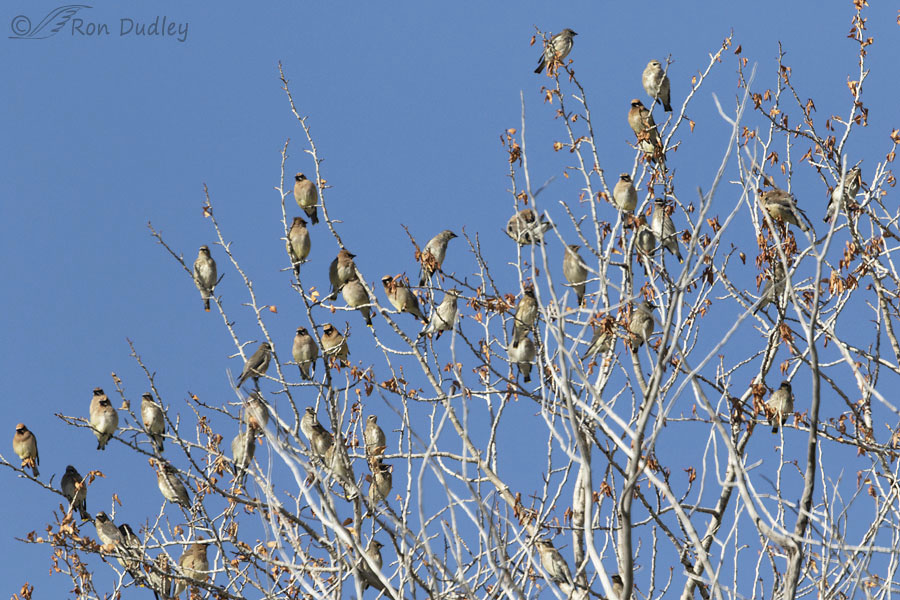
Cedar Waxwings are flocking, possibly in preparation for migration. Migratory flocks of 30-100 birds are common with this species so I suspect that may be what’s going on with this mixed group of adults and some juveniles.
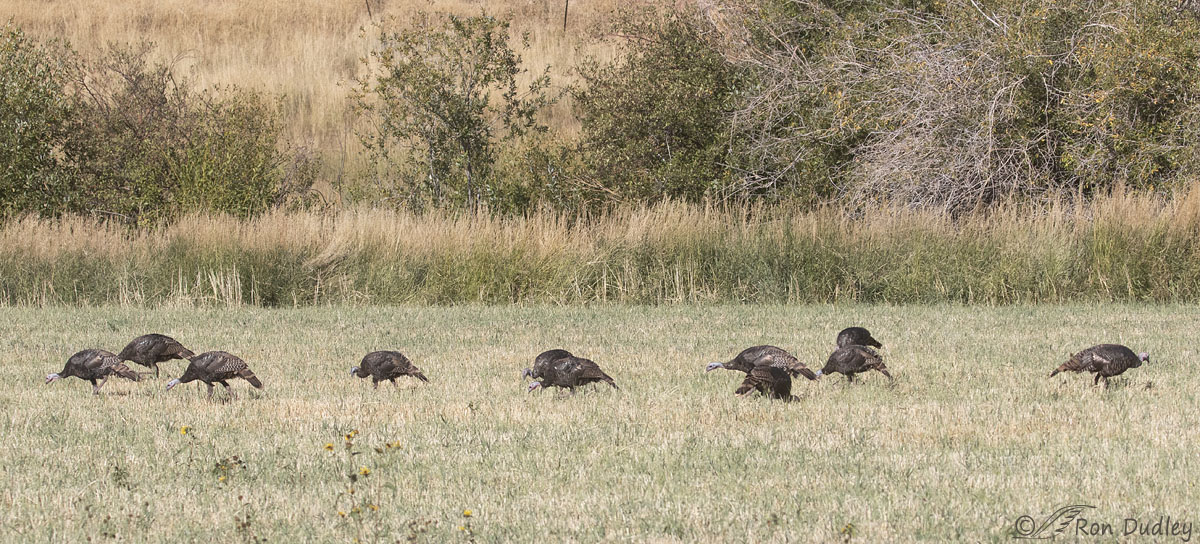
I’m finally beginning to see a few more Wild Turkeys. Here we see 11 birds out of a flock of 14 and there was another flock a short distance away as they foraged for food.
Turkeys are omnivorous with 90% of their diet being plant based. The other 10% is mostly invertebrates and these birds often appeared to be chasing down insects, grasshoppers perhaps. It was obvious they were trying to get to the food item before it escaped and before one of their companions got there first so it was amusing to watch them race each other as they competed for the snack.
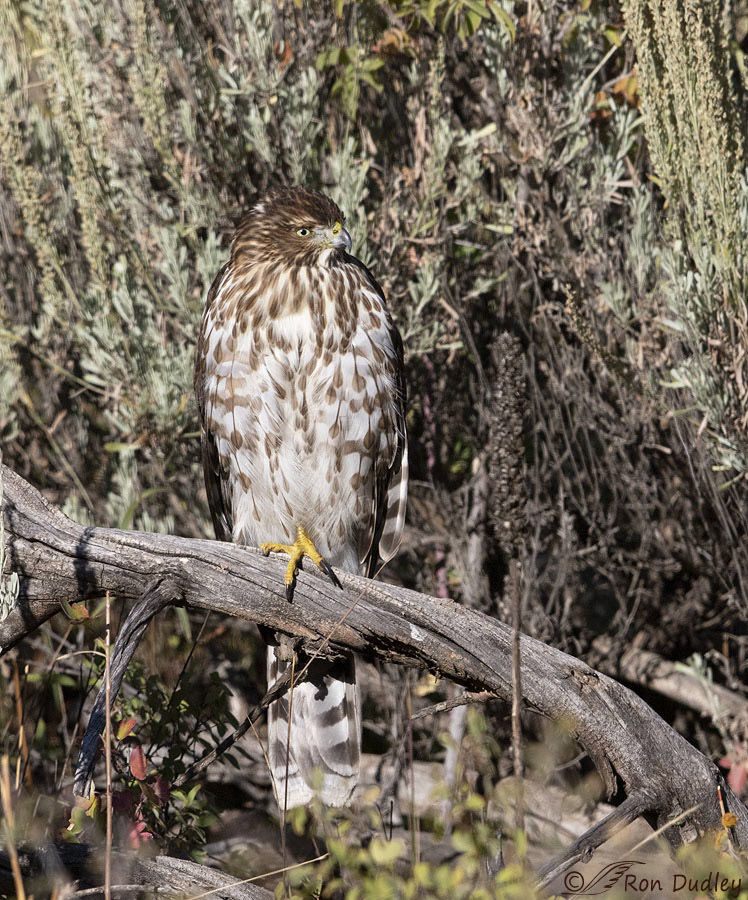
1/4000, f/6.3, ISO 500, Canon 7D Mark II, Canon EF 500mm f/4L IS II USM + EF 1.4 III Extender, not baited, set up or called in
In my experience with Cooper’s Hawks they’re very elusive and difficult to approach unless they’re “city birds” but this one didn’t fit that mold. I photographed it for quite a while from a close distance before eventually leaving it while it was still perched here. It actually seemed sleepy. I suspect it might have been migrating and was resting up before the next leg of its strenuous journey.
Although I like the perch I’m not particularly fond of the rest of the setting with all the clutter and the sagebrush so close to the bird. But I still prefer this kind of shot over…
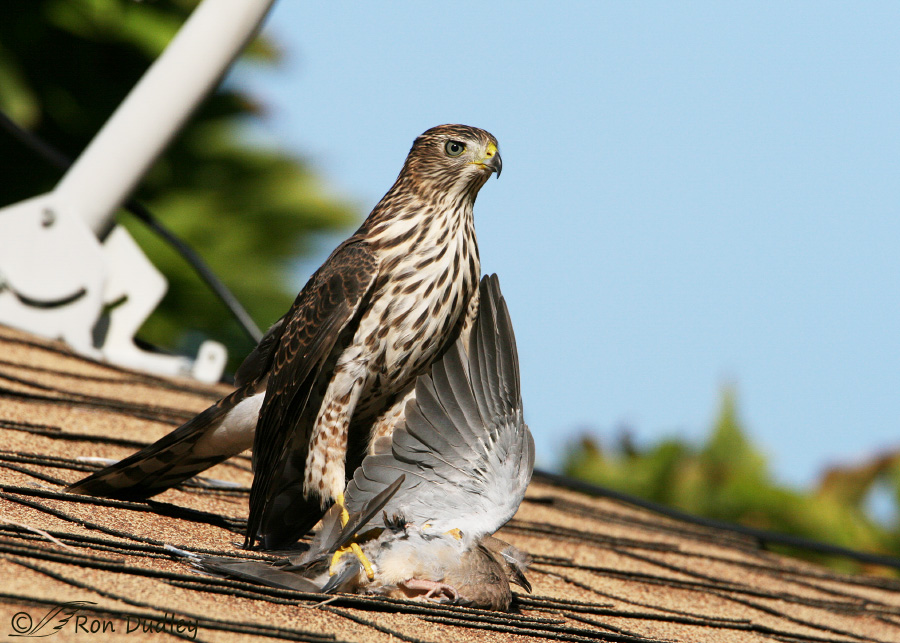
1/2000, f/8, ISO 400, Canon Digital Rebel XTi, Canon EF 500mm f/4L IS USM + EF 1.4 Extender, not baited, set up or called in
the urban settings where I usually have a better chance of getting close to them. This Cooper’s Hawk had knocked a Mourning Dove out of a tree in my back yard and then landed with its prize on my roof as the dove was expiring. This bird from 12 years ago was the first time I’d ever photographed a Cooper’s Hawk. I’m glad I have the shot for the behavior it documents but I’m sure not fond of the setting.
Asphalt shingles and satellite dishes – sheesh!
So, yesterday was another one of those days when I didn’t get any great shots but I was out in nature and experiencing some of the natural cycles of life so all was not lost.
Ron


I took a walk yesterday during a brief respite from the rain and saw one female mallard In the nearby pond, a rabbit, and some mushrooms. You win.
Gotta agree with EC; seeing an RTH anywhere is better than not seeing one (apologies to doves everywhere).
Some days that would beat me, Lyle. A lot of days, actually.
Nice post today…. a little bit of everything Fall is going to be a little late here in Sacramento, close to a hundred for a couple days
Fall is going to be a little late here in Sacramento, close to a hundred for a couple days 

We had five turkeys yesterday fluffing their feathers and napping in our front yard. It doesn’t take much to entertain me
Thanks, Diana. There are worse ways to be entertained…
It looks like a beautiful morning. Heart balm. Love the triumphant attitude which my anthromorphic self clearly sees in that successful hunter. (And a roof with a hawk is DEFINITELY more interesting than one without.
“And a roof with a hawk is DEFINITELY more interesting than one without”
Ha, excellent point, EC! I need an attitude adjustment…
Wonderful mix of shots today, Ron! That pop of color is so striking! Not cold enough here for chlorophyll to break down yet, although one tiny twig of my giant Liquid Amber tested the waters last week.
Does the Cooper’s Hawk have a left foot? I’m trying to make it out — there’s a shadow on the tail that could be interpreted as foot-like, but I don’t see any “claws.”
Thanks, Marty. If you’re asking about yesterday’s hawk (instead of the one in the last photo) yes, its left foot is pulled up into its belly feathers in a typical resting position for raptors.
Yes, yesterday’s hawk. Switched from the iPad to the computer and can sort of make out the bulge where the foot is drawn up.
I love photographing birds because gets me out there in the wild places. Even when the results are not so pretty I usually have a wonderful experience. Glad you enjoyed yoursel!
I agree and I did. Thanks, Joanne.
Nice to see the colors changing and the some of the migration evidence. If you have the Waxwings there it won’t be too long before we see them here. Some years they take over the trees up and down my street. I have often experienced getting close to Cooper’s Hawks here at some of our lakes, but I have a feeling that these hawks I see are often the same ones that frequent the neighborhoods. Two of our lakes are only two miles from my house so that’s just a few flaps of the wings away. Have also seen one take down Mourning Doves in my backyard. Never pretty or fun to watch, but it is nature. Good series Ron – thanks for sharing. Oh, and PS – I envy you your wild turkeys. I know we have some if you hike out a good distance, but I have never seen one here.
Everett, in some of the higher elevation towns around here turkeys are so numerous in winter they’re considered a nuisance by many. DWR often traps them in large numbers and relocates them.
Nice series… Colors changing here also tho none vivid like that – chokecherry brush seems to be the only thing that tends towards reds…
Colors changing here also tho none vivid like that – chokecherry brush seems to be the only thing that tends towards reds…  Used to be wild turkeys in the area but haven’t been in many years – may still be some S of us in the Belt area. Getting a clean shot of the wax wings is a challenge – at least here. I did recently find a juvenile perched low in a spruce with deer eaten branches that looked like a weird stick until I got close!
Used to be wild turkeys in the area but haven’t been in many years – may still be some S of us in the Belt area. Getting a clean shot of the wax wings is a challenge – at least here. I did recently find a juvenile perched low in a spruce with deer eaten branches that looked like a weird stick until I got close!  Love the hawk disregarding the background and the fact it landed close to you and wasn’t going to budge! A glorious day in nature for you!
Love the hawk disregarding the background and the fact it landed close to you and wasn’t going to budge! A glorious day in nature for you! 
Judy, having a Coop in the wild let me get close was a unique experience for me. That NEVER happens…
Beautiful. Isn’t the cycle wonderful to behold! I could not live where I did not experience the seasons of color changing and the comings and goings of nature. Your photographs are like my weekly trips to northern Michigan…my camera is near me always to document the changes. In fact your set matches mine of last week except for bits more color. The stag-horn sumac is close to it’s vivid red in all areas along the way. Your Cooper’s looks like the one that was my frequent visiter here last year…I await his return to see if he has changed into his ‘big boy garb’.
Thanks, Kathy. Yup, just being out there and experiencing it all means a lot.
Good morning, professor. Wish I could have seen those turkeys racing. Sounds like a fun time.
Same to you, Arwen. Turkeys can run fast when they need to…
Wonderful post, I enjoyed it very much. Except for the shingles and satellite dish the image of the Cooper’s is excellent! This Cooper’s has that arrogant look that says: “This is my dove, You want to make something of it!” or any other arrogant comment one wants to simulate.
Color is changing here as well, but not as vivid as your shot. We mostly have shades of yellows and some light reds. It has been in the 80’s the last two days, not conducive for Fall color. It is supposed to be cooler wiyh showers for the next two days.
Thanks for sharing.
Dick, that Coop certainly did have an attitude. When it knocked the dove out of the tree they both hit the ground in a tangle of flying feathers about 15′ in front of me. We both just stood there staring at each other – the fierce Coop was defiant that it wasn’t going to give up its prey and there I stood without my camera which was on my tripod on the other side of the yard (I had been working in the garden).
As I want to retrieve my camera the Coop flew to the roof of my house with the dove.